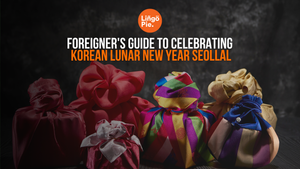My little soda pop... (shoulder dancing)
If you're like me, the Saja Boys have probably already stolen your soul just from looping the soundtrack. But behind the dazzling animation, jaw-dropping action, and K-pop perfection, K-pop Demon Hunters holds something even deeper: a rich tapestry of Korean culture, tradition, and shamanistic symbolism—woven seamlessly into the storyline, visuals, and characters.
It’s the kind of layered world-building that fans of series like Star Wars will appreciate, where every detail hints at a bigger universe.
In this article, we’ll dive into the Korean traditional easter eggs hidden throughout the film—from weaponry and costumes to ancient rituals and folk art—and discover how they elevate this movie into a cultural experience. This isn’t just a story about K-pop idols and demons—it’s a love letter to Korea’s spiritual past and creative future.
11+ Best Shows On Netflix To Learn Korean [2025]
12 Korean Myths And Legends Everyone Learning Korean Should Know
5 K-Dramas Like When Life Gives You Tangerines

The Saja Boys’ Dual Meaning Name:
The name “Saja Boys” is more than just a cool idol group moniker. In Korean, 사자 (saja) can carry two completely different meanings:
- 사자 (lion) – the fierce animal, often symbolizing strength and power.
- 사자 (messenger of the afterlife / grim reaper) – short for 저승사자, which means “reaper who guides souls to the afterlife.”
In the case of the Saja Boys, they are portrayed as grim reapers, not lions. The members are demons who try to steal their fans’ souls, which fits the dark and supernatural concept behind their group. The name adds depth and irony—sounding like powerful “lions,” but actually being soul-stealing reapers hidden behind a K-pop idol image.
This double meaning makes their name mysterious and playful, just like their concept.
Insider content:
I had the chance to watch this amazing Kpop Demon Hunters Drone Show in Seoul! Of course I didn't want to leave you out of this masterpiece!!
The show was held in Ttukseom Hangang Park, containing 1200 drones! I know, crazy right? It was packed of people, luckily we arrived 3 hours early and could get access to the seated area - there you could lay your picnic mat and watch the show conveniently, whereas if you got too late, you would have to stay further in the standing space. The show lasted around 15 minutes and I couldn’t believe my eyes! Not only it was my first drone show, I didn’t know they could make it so realistic and three dimensional!
@millyq.a The Honmoon is Sealed! This was definitely the prettiest thing l've seen! Kpop Demon Hunters Drone Show in Seoul #드론라이트쇼 #한강빛공원 #케이팝데몬헌터스 #kpopdemonhunters #hanganglightshow
♬ original sound - 𖡎
⚔️ Traditional Weapons: Straight from Korean History
Each Huntrix member wields a unique weapon, but these aren’t random fantasy blades. They’re deeply inspired by actual Korean historical arms and shamanic tools—and each one carries cultural weight.
🔹 Rumi’s Four Tiger Sword (사인검)
Rumi’s weapon is based on the Four Tiger Sword, a ritual blade used during the Joseon Dynasty. In Korean cosmology, the four cardinal directions are guarded by four mythic tigers, and this sword symbolizes their protective strength.
Not just a battle prop, this sword has spiritual significance—it was used in shamanic rituals to ward off evil, and its design reflects Dancheong patterns, the colorful motifs traditionally painted on Korean temples. In one variation, it even incorporates sound waves and text, combining old and new to reflect Rumi’s dual identity as a warrior and performer.
🔹 Mira’s Curved Sword (곡도)
Mira’s sword, Gokdo (곡도), was initially mistaken by viewers for a Chinese Guandao (월도), but concept art later confirmed it’s based on the Cheolyeomchu (철염추)—a curved polearm from the Goguryeo period (37 BC – 668 AD). This clarification sparked excitement among history buffs, as it showcased a lesser-known traditional Korean weapon on a global stage.
🔹 Joy’s Spirit Knife (신칼)
Joy’s weapon is perhaps the most symbolically powerful. The Shinkal (신칼), or spirit knife, is used in gut—Korean shamanic rituals—to fight evil spirits. In the film, it’s a summonable dagger, echoing the real-life ritual where shamans cast the knife toward evil, then reclaim it to restore spiritual balance.
Joy’s blade is also adorned with a norigae (노리개), linking it back to feminine spiritual power, aesthetics, and tradition. This blend of combat and ceremony is a highlight of the film’s dedication to authentic cultural storytelling.
💎 Clothing Acessories
If you pay attention to the clothing the girls' clothing you might realize there is a little pendent. The norigae is a traditional Korean pendant, usually worn by women with hanbok, and it's not just for show. Each norigae carries symbolic meaning—representing wishes for good luck, prosperity, or protection.
They often include:
- A main ornament (carved or beaded)
- Intricate knots (like maedeup)
- Silken tassels

In K-pop Demon Hunters, norigae appear as costume elements, props (like the lightstick), and weapon accessories. Their inclusion isn’t decorative—it’s intentional, celebrating Korean femininity, elegance, and spiritual symbolism.
🕊️ Shamanism and Gut: Korea’s First Performance Art
Director Maggie Kang revealed that the idea for the Huntrix came directly from Korean shamanism—especially the ritual known as gut (굿).
A gut is a dynamic ritual where a shaman (mudang) drives away evil spirits using:
- Music
- Dance
- Costume
- Incantations
Video from the netflix Movie Exhuma that represents the shaman ritual.
The similarities to a K-pop concert are uncanny—and that’s exactly the point. The Huntrix are modern-day performers whose roots trace back to ancient spiritual traditions. In the film’s lore, the first demon hunters were shamans, and their tools evolved into stage-ready weapons of power.
🔸 Women as Spiritual Leaders
In Korea, the majority of shamans are women. Gut rituals have historically offered women a rare space for power, performance, and healing. In this sense, the film highlights the connection between female strength, art, and cultural preservation—while giving fans magical girl aesthetics rooted in real history.
Tradition in Everyday Scenes
The film doesn’t only focus on grand mythical elements—it also carefully incorporates everyday Korean life and tradition:
- Hanok & Giwajip: Traditional homes with tiled roofs serve as stunning backdrops.
- Hanuiwon & Hanyak: Korean medicine clinics and herbal remedies are featured, spotlighting the country’s unique wellness culture.
- Dining etiquette: From the way food is served to napkin placement, the film mirrors Korean manners.
Even foods like kimbap and ramyeon appear naturally, making the movie feel grounded in real Korean culture, even amid supernatural chaos.
Folk Tales: Jakho-do, the Magpie and the Tiger
One of Korea’s most beloved folk images is the Jakho-do (작호도). Jakho-do is a representative style of minhwa (Korean folk painting) from the late Joseon period. It is a symbolic painting that depicts a magpie and a tiger together in a single scene, characterized by detailed and realistic rendering. The tiger symbolizes powerful and authoritative figures, such as corrupt officials, while the magpie represents the common people.
In these paintings, the tiger is depicted foolishly, while the magpie appears dignified. The tiger is often shown being flustered or overwhelmed by the magpie. This serves as an allegorical and satirical representation of social conflict between classes.
The film reimagines this satire through the characters Duffy (a tiger yokai) and Suzy (clever and resourceful). Duffy is clumsy and innocent, while Suzy is sharp and strategic—honoring the humor and social commentary of old folk art in a fresh way.
Some fans interpret the ending—where both the magpie and tiger remain—as a hopeful sign that balance is restored, and perhaps even that Jinwoo’s soul still lingers.
👘 Hanbok in the Spotlight
Fans were curious about the hanbok-style outfits worn by the Saja Boys during their reaper performances. According to the hanbok brand Leesle, the designs resemble sochang-ui (소창의)—a simplified, modernized hanbok form often used in performances or reinterpretations.

These modern hanboks allow for movement and flair, matching the group’s choreographed battles while preserving traditional silhouettes and aesthetics.
🏙️ Modern Meets Traditional: Cultural Symbols Reimagined
The film also blends old and new Korea seamlessly:
- Namsan Seoul Tower represents the modern skyline.

- The lightstick draws from norigae design, merging fandom culture with heritage.
- Duffy’s merch—especially the Magpie & Tiger badge from the National Museum’s “Myuz” collection—sold out after the film’s release, showing how pop culture and history can collide in meaningful (and profitable) ways.
🌍 A Global Hit That Stays Local
K-pop Demon Hunters became an instant hit, ranking #1 on Netflix Korea and topping charts in 41 countries just days after its release.
Though produced overseas, its meticulous attention to Korean history and aesthetics earned it praise from Korean viewers and scholars alike. Director Maggie Kang said she wanted the film to be “as Korean as possible”, and every frame delivers on that promise.
Learn Korean With Lingopie
Want to understand the wordplay behind 사자 or recognize a 신칼 at a glance? Lingopie lets you learn Korean through real media—from dramas and variety shows to movies and K-pop content.
With interactive subtitles, in-context vocabulary, and culturally rich shows, you’ll absorb:
- Unique expressions
- Everyday speech you hear in scenes with herbal clinics or dinner tables
🎬 Watch. Learn. Connect. The Lingopie Way.
Whether you're here for the action, the lore, or the idols, K-pop Demon Hunters proves that modern media can be a gateway to ancient wisdom. And with Lingopie, you can explore that gateway in your own language journey.
Ready to start? Learn Korean while discovering the soul of its culture. Only with Lingopie.




![How To Say Happy Birthday In Hebrew Like A Native Speaker [Guide]](/blog/content/images/2025/09/Happy-birthday-in-hebrew.png)




